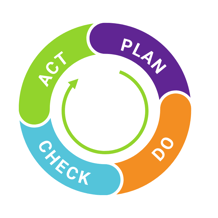It has been over 40 years since educator Rick DuFour and Adlai E. Stevenson High School in Lincolnshire, Illinois put professional learning communities (PLCs) on the map. Recognized as a model of successful school reform, professional learning communities have gone on to become a commonplace term in education jargon.
The term is often overused to describe any loose coupling of teachers, jeopardizing the integrity of the term. So what is a professional learning community? This blog post will examine what constitutes a PLC, why you would want to implement a PLC in your organization, and what it takes to have a high-functioning PLC process.
DuFour and his colleagues define a professional learning community as ‘an ongoing process in which educators work collaboratively in recurring cycles of collective inquiry and action research to achieve better results for the students they serve’ (p.10).1 It is not a meeting, a book study, or a program.
A professional learning community is representative of the school or district immersed in the process of continuous job-embedded learning for the adults in the organization to impact student learning positively.
The 3 Big Ideas of a PLC
1) A Focus on Learning
In an organization that functions as a PLC, there is a shared vision that embraces high levels of learning for ALL – staff and students alike. Educators take full responsibility for ensuring that all students acquire the essential knowledge and skills of their course, grade, or subject.
In doing so, they embrace the four big questions of a PLC:
- What is it we want students to learn?
- How will we know when they have learned it?
- How will we respond when they don’t learn it?
- How will we deepen the learning for students who have demonstrated proficiency?
They are crystal clear about what each student must learn, what evidence of learning will look like, how to provide systematic interventions to those who struggle, and how to extend learning for students who have mastered the learning goals.
And being a learning community, the adults in the community must also be continually learning. Structures are put in place to ensure job-embedded learning is part of the day-to-day functions of the community.
2) A Collaborative Culture and Collective Responsibility
Professional learning communities bring educators together to focus on learning, not teaching. Functioning as a team to ensure ALL students learn is not an option, rather it is a requirement. This means there is an expectation for team members to work interdependently and be mutually accountable for student learning. Teaching practice is de-privatized and data is shared to facilitate the common purpose of learning for all.
Teams meet in recurring cycles of collective inquiry to build shared knowledge and social capital (teachers learning with and from one another) around teaching practices leading to better results for students. Teams are action-oriented, taking collective responsibility for the success of each student.
3) A Results Orientation
Finally, PLCs are driven by results – evidence of student learning. Student learning drives the continuous improvement cycle. Team members reflect on student learning and use this evidence to inform their practice and respond to student learning needs, both intervention and enrichment.
The cycle of continuous improvement follows the plan-do-check-act process. Team members plan and implement the learning experiences, check or gather evidence of student learning, analyze evidence of student learning, develop strategies to address weaknesses or build on strengths of individual student learning, and implement those strategies. And the cycle repeats – plan, do, check, act.
Conditions for a PLC
PLCs don’t just ‘happen’. Conditions must be intentionally created for successful learning by all – students and school staff alike.
- First, teams must be provided with protected time to meet. Without allocated time within the structure of the workday, this vital work will not occur.
- Next, teams must also be provided with the tools and structures to be successful. This includes helping teams understand the collective inquiry or plan-do-check-act cycle. They must be adept at analyzing and interpreting student data. And extremely important, the environment must be conducive to risk-taking and innovation to improve learning while fostering trust and respect among team members.
- And last, but certainly not least, the school administrator is pivotal in setting the school's direction, developing people, and redesigning the organization to function effectively as a learning community. To develop teams that are goal-oriented, collaborative, and results-driven, the administrator must lead from the middle, empowering staff members, building capacity, and nurturing collaboration to improve student learning.
Benefits
The benefits of an organization functioning as a professional learning community are well-documented. For teachers, participating in a high-functioning PLC creates a shared sense of responsibility and collective efficacy, new learning and beliefs about teaching practice and learners, and higher morale. The benefits for students include larger academic gains, decreased dropout rates, and reduced achievement gaps.
The research is clear – when schools function as professional learning communities, they become places of learning rather than places of teaching.
Littlestown’s Story
Background
In the 2017-18 school year, the Littlestown Area School District adjusted the school day to allow dedicated time for teachers to collaborate. The guiding coalition knew that building social capital was the key to positively impacting student learning.
Now, five-plus years into implementation and one can see the results of a re-culturated school system that includes systematic, job-embedded, and site-specific collaboration. While learning communities may look different from building to building, the constant is an unyielding focus on student learning.
In the school year prior to the rollout of collaboration time, a guiding coalition was formed and support or ‘buy-in’ was garnered from multiple stakeholder groups including administrators, teachers, board members, and parents. Logistics around busing and instructional minutes had to be considered.
Finally, it was imperative to communicate a consistent message of the ‘compelling why’ behind the structured time for teacher collaboration – time for staff to reflect on professional practice, try new instructional strategies, and get feedback from colleagues to positively impact teaching and learning.
In the first year of implementation, expectations were communicated, norms were established, and inquiry cycles were introduced. As with any change, both successes and challenges were experienced. While some embraced the concept of a professional learning community, others still questioned it. Some went through the motions without seeing the true potential of teacher collaboration.
Inquiry cycles that were to take several weeks to accomplish, were completed in mere days with teachers asking what they were to do next. But with time, the inquiry cycle provided a framework for examining teacher practices and gauging student learning. The teams settled into a rhythm and collaboration time became part of ‘how we do school’.
Littlestown Today
Today, ‘PLCs’ have morphed into high-functioning teams. At the elementary level ‘PLC time’ is used for grade-level inquiry cycles around student learning, as well as time for cross-grade level professional learning in literacy and math. The power of teacher leadership is harnessed to lead the professional learning modules and facilitate teachers learning together.
At the secondary level, ‘PLC time’ is allocated to cross-curricular and department workgroups. Teachers collaborate to analyze data, audit curriculum units, examine student work, and observe each other’s classrooms. They use their learning to positively impact practice and thus, student learning.
The district has truly become a place of learning, rather than a place of teaching.
Eduplanet21 & PLCs
At Eduplanet21, we believe in the power of teacher collaboration as part of continuous improvement in schools. In fact, collaboration is embedded in both professional learning and curriculum development modules.
With Eduplanet21’s PLUS Professional Learning Institutes, schools can establish smaller PLCs so similar groups can participate in learning together. Some customers are segmented by grade levels or subjects, and some bring paraprofessionals together in a learning cohort. A ‘best practices’ approach is discussed as part of your work with your Customer Success Manager.
When developing and reviewing curriculum, collaboration is encouraged within the platform. Teachers can see the courses and units that are taught across the school/district, including what students are learning before coming to their class and what they need to know for the next year. Within the platform, teachers work together to build a meaningful curriculum that positively impacts student growth and achievement.
By collaborating on the platform, educators are learning and growing together -- building social capital to increase student learning.
About the Author
Dr. Lori Stollar has served as a Director of Curriculum & Technology, a Professional Development Specialist, an adjunct professor, and a high school social studies teacher. She recently retired after having served 35 years in public education.
Lori is passionate about helping teachers and school leaders positively impact student learning. Her research interests are in professional learning communities, collective teacher efficacy, and classroom instruction.
References
1 DuFour, R., DuFour, R. B., Eaker, R. E., Many, T. W., & Mattos, M. (2016). Learning by doing: A handbook for professional learning communities at work. Solution Tree Press.
2 Leana, C.R. (2011). The missing link in school reform. Stanford Social Innovation Review. Fall 2011. DOI: 10.48558/t2gn-2980
 Login
Login

